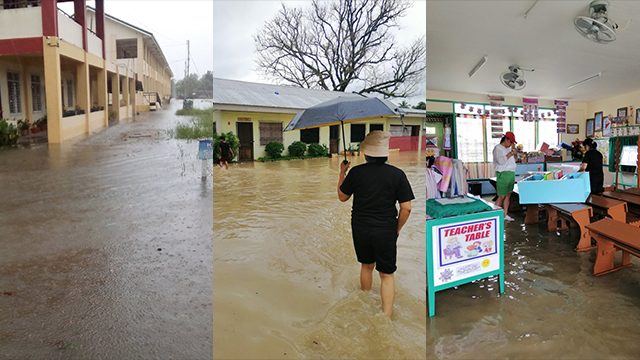SUMMARY
This is AI generated summarization, which may have errors. For context, always refer to the full article.

MANILA, Philippines – In 2018, just days after Christmas, Tropical Depression Usman stormed through parts of Luzon and Visayas and dumped large volumes of rainfall in just two days.
The onslaught of Usman brought flooding caused by heavy rain in several parts of the country. Landslide incidents were reported in areas in Albay and Camarines Sur.
How did Usman affect schools?
At a situation briefing led by President Rodrigo Duterte in Camarines Sur, Education Secretary Leonor Briones gave a tentative estimate of P237 million ($4.52 million)* in damage to school buildings in affected areas. This excludes the school computers funded by the Department of Education (DepEd).
Aside from damage to school infrastructure, Tropical Depression Usman also claimed many lives.
As of January 3, the National Disaster Risk Reduction and Management Council reported 122 deaths related to Tropical Depression Usman. At least 28 people also remained missing, while 60 were injured.
Briones disclosed in the situation briefing on Friday, January 4, that 32 of the casualties were learners.
“When these tragedies happen at night, usually the children are the most helpless,” Briones said.
In case of disasters, the DepEd has a quick response fund of P2 billion ($38.17 million). However, with the extent of the damage brought by Usman and other disasters in 2018, Briones shared that DepEd may have exhausted all available funds for quick response.
“We estimate already that with Ompong, and the other earlier disasters, maubos na ‘yung P2 billion na ‘yan (the P2 billion will be used up) plus Usman. So after Usman, we probably will already have exhausted available funds for quick response,” Briones said.
Although schools are built to withstand disasters that bring strong winds, Briones noticed that it may be time to adjust school infrastructure according to new natural hazards in the area.
“We have been watching the pattern of the damage caused by natural disasters and traditionally, this will be caused by strong typhoons, strong winds…. But now we noticed that a tropical depression can unleash and trigger tragedies and destruction of even greater magnitude. This is because of floods and landslides,” she explained.
In light of recent disasters, Briones said features protecting schools from natural hazards may need to be reevaluated, especially if a tropical depression could already trigger floods and landslides.
Although DepEd’s current concern is to fix damaged school buildings, Briones also proposed changes that may help schools cope with landslides and floods.
These include slope protection for schools found at the foot or top of hills, higher elevation of schools, and the transfer of schools from sites that were previously deemed safe but have become hazardous areas.
“We cannot be business as usual in the usual preparation for typhoons…. We have to include already flooding and landslides because na-weaken na ang ating (it has already weakened our) geological atmosphere. This requires huge budgetary outlays,” Briones said.
Lessons learned
The damage brought by Tropical Depression Usman may be attributed to a number of factors. During the situation briefing, Department of Science and Technology Undersecretary Renato Solidum Jr. mentioned the problems brought by development, if not done right.
He pointed out that many of the landslides in the Bicol region were along road cuts. Many houses were also built on road easements and the lower end of roads.
“With the development, we also have to make sure that we employ slope protection, [and] drainages ng ating mga ginagawang kalsada (for the roads that we make), so that these will not be the site of future landslides,” Solidum said.
Aside from problems in development, people residing in the affected areas experienced nearly a whole month’s worth of rain in just two days.
Though tropical depression is the lowest category of a tropical cyclone in terms of wind speed, it is still very dangerous. And since Usman moved very slowly, it brought a lot of water.
Solidum explained that as Usman neared Visayas, it progressed slowly and almost parked, dumping more rain to affected areas since it did not move.
“If the tropical cyclone would have moved faster, then the rainfall in the Bicol area may not be very high, but still, it’s way above the threshold of triggering landslide and flood,” he added.
Recently, the Philippines has seen a number of landslide tragedies. Solidum attributed it to a combination of many factors, including global warming.
“One is the changing climate, plus the fact that ‘yung mga soil, with time, nagiging weathered, mas erodible. ‘Yung mga daan po from Tiwi to Sagnay ay easily erodible material. Unfortunately, doon po karamihan sa kalsada nagsimula ang mga landslide,” he explained.
(One is the changing climate, plus the fact that the soil gets weathered and erodible over time. The paths from Tiwi to Sagnay have easily erodible material. Unfortunately, it’s in many of those roads that the landslides started.)
Solidum reminded people to not be complacent and be on alert for PAGASA’s forecasts. (FAST FACTS: Tropical cyclone, rainfall advisories)
“We really have to make sure that we don’t focus only on the typhoon signal, which refers to the wind strength, pero kailangan din po na madalas balitaan natin kahit hindi na malakas ang ulan, marami pa ring tubig na babagsak (but it’s also important to be updated even if the rain isn’t that strong, because it might still dump a lot of water),” he added. – Rappler.com
*$1 = P52.45
Add a comment
How does this make you feel?
There are no comments yet. Add your comment to start the conversation.